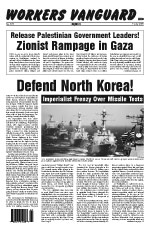
The ILWU Militant Caucus' Fight for Anti-Apartheid Labor Action The Truth About the 1984 Nedlloyd Kimberley Boycott In late 1984, longshoremen in San Francisco refused to touch South African cargo aboard the Nedlloyd Kimberley in solidarity with black South African workers battling the racist apartheid regime. The significance of American workers taking union action against apartheid was such that Nelson Mandela made a point of thanking the longshoremen following his release from the apartheid prisons in 1990. In the years since the boycott, everyone from the International Longshore and Warehouse Union (ILWU) bureaucracy to the leftover Stalinists of the Communist Party (CP) to the dubious “International Bolshevik Tendency” (BT) has rushed forward to claim this action of international solidarity as his own. On the contrary: all honor goes to the longshoremen. For ten days, not a man touched that South African cargo despite being set up for individual victimization by the ILWU bureaucracy and its Stalinist and BT front men, who did their level best to sabotage union action against the apartheid regime. For 20 plus years, the BT has tried to cover the dirty role its supporter Howard Keylor played—hand in hand with the Stalinists and the labor bureaucrats—with slanders that it was the Spartacist League and its well-known supporter, ILWU Local 10 Executive Board member Stan Gow, who “sabotaged” the boycott of the Nedlloyd Kimberley. More than two decades later, when what actually happened on the docks in 1984 is unknown to a new generation of longshore workers and others, it’s important to set the record straight, not least because the real story of the boycott of the Nedlloyd Kimberley provides lessons in the fight for an internationalist class-struggle perspective. 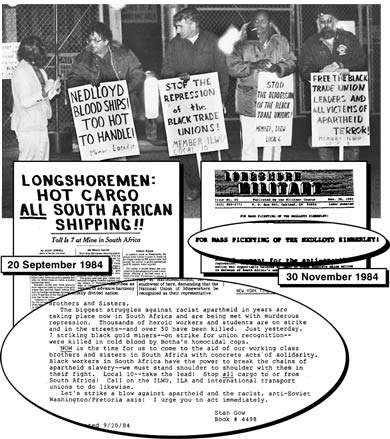 ILWU Militant Caucus fought consistently for class-struggle action in support of South African black masses. Left: Stan Gow leaflet calls for union boycott of South African shipping. Top: Gow (third from left) and other union militants picket Nedlloyd Kimberley, 24 November 1984, in San Francisco. Right: Longshore Militant calls for mass union picketing of the ship. Solidarity with Black South African Workers Throughout the 1970s and ’80s, a rising tide of black workers struggle in South Africa, from strikes in auto factories to dock workers fighting for union recognition, shook the hated white-supremacist apartheid regime. Black people in this country identified strongly with these struggles, justly seeing in South Africa the reflection of black oppression in the U.S. By late 1984, the recently organized National Union of Mineworkers led strikes by thousands of black gold miners, and black townships erupted over rent increases and a new apartheid constitution. All these struggles were met with fierce repression. Cops and troops opened fire on strikers and township residents and carried out mass arrests. Our front-page article in Workers Vanguard No. 362 (14 September 1984), titled “Smash Apartheid—For Workers Revolution! Black Masses Revolt in South Africa,” urged: “At this crucial moment all class-conscious workers and enemies of racist oppression must act in solidarity with South Africa’s black toilers. For mass, united-front protests against apartheid terror! For international labor boycotts of all cargo to and from South Africa!” In ILWU Local 10 in San Francisco, Stan Gow, a longtime union militant and a member of the Militant Caucus in the ILWU, whose work was politically supported by the Spartacist League, issued a leaflet in the union on 20 September 1984 under the call: “LONGSHOREMEN: HOT CARGO ALL SOUTH AFRICAN SHIPPING!!” Gow, who was still recovering from having seriously injured his back in an industrial accident on the docks the previous June, urged: “NOW is the time for us to come to the aid of our working class brothers and sisters in South Africa with concrete acts of solidarity. Black workers in South Africa have the power to break the chains of apartheid slavery—we must stand shoulder to shoulder with them in their fight. Local 10—take the lead! Stop all cargo to or from South Africa! Call on the ILWU, ILA [International Longshoremen’s Association] and international transport unions to do likewise.” The members of Local 10, not least the black workers who made up the majority of its membership, wanted the union to take action against the hated apartheid regime. But the ILWU bureaucracy didn’t want to do anything that would mean going up against the maritime bosses. Coming to their aid were a couple of operators in the union who worked to undermine a solid union action. First was Howard Keylor, a member of the Local 10 Executive Board at the time, who is a longtime supporter of the so-called “Bolshevik Tendency” (then known as the “External Tendency” [ET]). Three weeks after Gow issued his September 20 call, Keylor put up a watered-down motion for a one-shot boycott of “the next Nedlloyd Line ship carrying South African cargo to the Bay Area” at an October 11 meeting of the Executive Board. Even the boycott of a single ship was too much for Leo Robinson, then known as a supporter of the Communist Party in the union. At the Local 10 membership meeting on October 18, Robinson amended Keylor’s motion to call for longshoremen to work the ship and refuse to unload only the South African cargo. With Keylor’s support, the amendment passed while the bureaucracy kept Gow’s proposal to shut down all South African shipping from coming to a vote. This “work the ship, not the cargo” motion fell far short of mobilizing the ILWU’s power in a coastwide emergency boycott of all South African shipping, an action that could have had explosive impact and would have struck a real blow against the apartheid regime. Nonetheless, as we wrote at the time, despite its limitations the motion posed taking “concrete union action in defense of South Africa’s embattled black toilers” (see “Longshoremen: ‘Hot-Cargo’ South African Butchers!” WV No. 365, 26 October 1984). But concrete union action wasn’t what the ILWU bureaucracy had in mind. The bottom line for the ILWU tops, headed by International president Jimmy Herman, was that there would be no official union backing for the work action because that would violate the contract with the Pacific Maritime Association (PMA) bosses. And their purposes were served by Keylor and Robinson. Longshoremen were left to go it alone, dispatched to the ship where they refused to work the South African cargo and then were fired for the day. Throughout, the ILWU tops declared that the boycott was not sanctioned by the union. This charade was complemented by daily protests at Pier 80 by Bay Area rad-libs, reformists, Democratic Party politicians and others whose purpose was simply to provide “moral witness” for the longshoremen. When the PMA got a court injunction against the boycott, the Local 10 leadership immediately capitulated, the boycott was scuttled and the South African cargo unloaded. Twenty years later, in December 2004 at an anniversary commemoration of the boycott of the Nedlloyd Kimberley by ILWU Local 10, Robinson and Keylor alternately claimed credit for initiating this labor action. Needless to say, the role played by Stan Gow in fighting to build a solid union action was disappeared. On the contrary, long after the fact, Keylor saw the opportunity to peddle the self-serving lie that Gow and the Spartacist League had tried to wreck the boycott. This slander is echoed in the pages of the BT’s publications, where we stand accused of sabotaging the boycott, of calling the longshoremen who carried it out “scabs,” and of providing “Exhibit No. 1” to the maritime bosses to get a court injunction against the action.  Leo Robinson (right), Howard Keylor (second from right), seen with Democrat Julianne Malveaux at Pier 80 in 1984, undermined a solid union action against the Nedlloyd Kimberley. As Leon Trotsky—co-leader with V.I. Lenin of the October Revolution of 1917 —argued in his concluding speech at the 1937 Dewey Commission hearings on the Moscow Trials, answering the outrageous slanders by the Kremlin Stalinists that he had engaged in a “conspiracy” with Hitler: “I wrote books, articles and letters and held conversations devoted to the defense of Socialism, the proletarian revolution and the struggle against fascist and all other forms of reaction.... One gets the impression that I built a skyscraper to ‘camouflage’ a dead rat. No, it is not convincing!” (The Case of Leon Trotsky, 1937). Similarly, everything that the SL wrote at the time of the Nedlloyd Kimberley boycott and all of the actions taken by Stan Gow and the Militant Caucus to make this a solid union boycott of South African shipping stand as a total refutation of the BT’s smears. One need only look at the historical record, which we preserve in carefully indexed bound volumes of Workers Vanguard. This is not camouflage for a “dead rat.” But the BT’s slander that we tried to “wreck the 1984 boycott of South African cargo by longshoremen in the port of San Francisco”—as they wrote in their 2005 pamphlet “Whatever Happened to the Spartacist League?”—is indeed nothing more than camouflage for their role as “rats on the waterfront” during this action. A Class-Struggle Fight Stan Gow was a militant and longtime Local 10 Executive Board member with 25 years of accumulated authority in the union at the time of his 1984 call to action against apartheid. That call was based on a decade of work by the Longshore Militant and the Militant Caucus in fighting for the ILWU to take class-struggle action to aid the workers and oppressed internationally—from union leaders imprisoned in the torture chambers of Pinochet’s Chile to leftist rebels fighting against the U.S.-backed junta in El Salvador to African National Congress (ANC) guerrilla fighters and black workers battling the apartheid regime. The ILWU bureaucracy has a long history of fine words of “solidarity” that cover for inaction or betrayal in practice. During the Vietnam War, for example, historic ILWU leader Harry Bridges made much of his opposition to this military onslaught by U.S. imperialism against the Vietnamese workers and peasants. ILWU banners flew at the antiwar demonstrations of the time. A boycott of U.S. military shipments to Vietnam by the ILWU would have had a greater impact, by orders of magnitude, than all of the antiwar protests. It also would have had an explosive effect in advancing the workers’ struggles here “at home.” But Bridges made sure that military shipments were kept moving during the 1971 longshore strike, saying it would help “get this war over faster.” As the Militant Caucus wrote in its Longshore Militant (4 January 1985—misdated 1984 in the original): “For a long time, Stan Gow has been arguing that there are two counterposed political programs at work in the ILWU and other unions. Stan and the Militant Caucus have fought for the program of militant class struggle and political action independent of the capitalist parties, courts and government. This program is based on the fact that the bosses own the government, and together they are the enemies of working people and always will be until the working people take over society. The other program, represented by the International officers and the revolving door of Local 10 ‘leaders’, is class collaboration, a legalistic strategy that says there is a partnership between labor and the bosses, and that the government can be pressured to be a friend of the working man—as long as we obey its laws. This is a lie. “What these counterposed programs mean in action was very clearly shown in the sabotage of the potentially powerful union action against South African cargo aboard the Nedlloyd Kimberley.” At the time of the boycott, U.S. imperialism’s renewed Cold War against the Soviet Union was white hot. The apartheid butchers were the “free world” allies of the racist rulers of this country. So too were the sadistic rulers of El Salvador, whose war against leftist insurgents was bankrolled and armed by the Reagan government. The “war against Communism” abroad was matched by a war against the unions, black people and other minorities and the poor at home. The AFL-CIO bureaucracy served on the front lines in fomenting the cause of capitalist counterrevolution in the Soviet Union and East Europe. In collaboration with the CIA, they played a key role in bankrolling and backing reactionary Solidarność, which spearheaded capitalist restoration in Poland. At home, the union tops openly acted as the bosses’ agents in enforcing givebacks and concessions and sabotaging strikes against these attacks. Their “answer” to the union-busting assault that had opened with Reagan’s destruction of the PATCO air traffic controllers union was to go all out in hustling votes for the Democratic Party in the 1984 elections. And the Democrats lost big. At the same time, strikes by South African workers and students were having an electrifying impact on black people and opponents of racism in the U.S. Black Democrats, seeking to refurbish their image after having delivered a massive black vote for the Democratic Party, tried to put themselves at the head of the burgeoning protests against apartheid. As we wrote at the time: “They know what a tremendous impact a black-centered revolution in South Africa would have on American blacks, and their job is to head it off” (“Black Democrats ‘Discover’ South Africa—Free South African Black Militants!” WV No. 368, 7 December 1984). 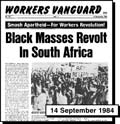 Spartacists fought for international working-class solidarity with black South African masses against apartheid capitalism. With the reformist left in tow, the black Democrats and labor tops appealed to the racist U.S. imperialist rulers to stop investing in South Africa. This “divestment” campaign was premised on illusions in the “democratic” credentials of American capitalism, whose profits are no less extracted through brutal exploitation that is reinforced by racial oppression. Moreover, had the imperialists massively divested their holdings in South Africa, it would have meant mass layoffs and even greater destitution, weakening the power of black workers to fight against the apartheid regime. Instead of impotent appeals to the “good will” of U.S. imperialism, Stan Gow and the Militant Caucus fought to bring the social power of organized labor to bear in struggle against the apartheid regime and to advance the class struggle of the workers in this country against their own capitalist rulers. The Militant Caucus’ program of working-class political independence stood in opposition to the ILWU bureaucracy’s support for the capitalist Democratic Party, through which the working class and black people are shackled to their exploiters and oppressors. Gow’s struggle was rooted in an internationalist revolutionary perspective of fighting to defend the workers’ gains that were embodied in the collectivized property of the Soviet workers state despite its degeneration under the rule of the Stalinist bureaucracy. It was part of the fight to build a new leadership of the unions—based on the policy of class struggle, not pandering to the class enemy—and for a revolutionary workers party. The Longshore Militant was founded in 1975 by Stan Gow, together with Howard Keylor. But Keylor, faced with the all-sided reaction in Reagan’s America, threw in the towel in the fight for a class-struggle opposition in the union. He quit the Militant Caucus in 1981. A year later, he lent his support to the foundation of the so-called “External Tendency.” The ET was a bunch of quitters, too—people who had individually left the Spartacist League in the early 1980s. Their fear of that period of anti-Soviet reaction was matched by a distaste for our response to it: work among the black masses to galvanize resistance to racist terror; political combat against the pro-imperialist trade-union bureaucracy; unconditional military defense of the Soviet degenerated workers state. In particular, our calls to hail the Soviet Red Army intervention in Afghanistan against CIA-backed Islamic reaction and to stop Solidarność counterrevolution in Poland had them running. What later brought these quitters together was intense subjective malice against the party they had fled. Such political positions as the ET espoused in its early days were colored by Keylor’s aspirations to influence within the union bureaucracy. When Keylor split from the Militant Caucus, he couldn’t move fast enough to offer his services to the bureaucracy against Stan Gow and the Militant Caucus. In 1983, Gow was put on trial by the Local 10 tops for fighting to put some teeth into the ILWU’s paper opposition to U.S. arms shipments to the blood-drenched Salvadoran junta by picketing a ship bound for El Salvador. In a 15 May 1983 leaflet hypocritically titled “No Trial Against Stan Gow!” Keylor boasted that he “had conducted an independant [sic] investigation of the facts and wanted to present his findings to the [Executive] Board”! Some defense! Keylor ridiculed Gow’s action as a “stunt” and “a sign of growing disorientation and disbelief that union members could be won to action” (Militant Longshoreman, 7 January 1985—misdated 1984 in original). The membership didn’t think so. After Gow was convicted by the bureaucracy, he mobilized support among the union ranks, who voted down his conviction by a ten-to-one margin amid chants of “No! No! No!” A key component of this victory was the June 1983 picket by Gow and the Militant Caucus of none other than the Nedlloyd Kimberley to protest the execution of ANC fighters. Keylor mocked this action as well, but it found ready sympathy in the local, particularly among its black members. 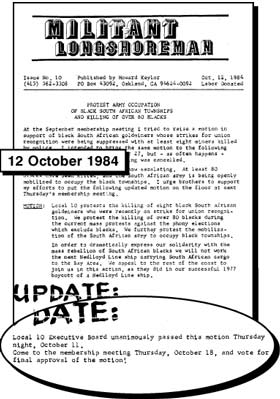 Giving the lie to BT slander: Keylor’s Militant Longshoreman published Local 10 Executive Board motion calling for a boycott. BT/Stalinist “United Front” In the 1984 boycott of the Nedlloyd Kimberley, Keylor cemented an alliance with the Stalinists. He attacked Gow for making much of “the difference between working the cargo and working the ship,” dismissing this as “just a matter of tactics.” But this had been a longstanding fight in the ILWU. It was Jimmy Herman—then the president of ILWU clerks Local 34—who, backed by Robinson, introduced the “work the ship not the cargo” subterfuge in 1977 over a boycott of the very same Nedlloyd Kimberley. At the time, Keylor, then co-publisher of the Longshore Militant, fought together with Stan Gow against Herman’s attempt to undercut the boycott. In 1984, Keylor was working the same side of the street as Robinson and Herman. The first Nedlloyd ship that pulled into port in the Bay Area following the 1984 “work the ship not the cargo” Local 10 motion was the Nedlloyd Kyoto, carrying South African pig iron. All of the cargo on the ship was worked. Gow’s Longshore Militant No. 65 (19 November 1984) described what happened: “[T]he Kyoto’s schedule was changed and it arrived here on Nov. 8 (instead of Nov. 14), where it was diverted to the Levin Terminal in Richmond where 1500 tons of pig iron from South Africa were off-loaded by members of Operating Engineers Local 3! But the Levin Terminal uses ILWU linesmen, who were dispatched and who did tie up the Kyoto. (Howard Keylor is a linesman. Why didn’t he blow the whistle?)” In his own newsletter, the Militant Longshoreman (7 January 1985), Keylor waxed apoplectic about this “slander.” He argued that a boycott of the Kyoto might not be successful “without adequate preparation” to get the Operating Engineers on the boycotters’ side. But if the ship is not tied up to the dock, it can’t be unloaded. Thus Keylor’s arguments were an implicit admission that he opposed stopping the Kyoto blood cargo in Richmond. After they knew the Kyoto was gone, Keylor and Leo Robinson held a meeting to plan a demonstration...if it should return. In contrast, Stan Gow and the Longshore Militant (No. 65, 19 November 1984) fought to keep the membership alert to the arrival of the Nedlloyd ships: “The time to act is now! It is reported that the Nedlloyd Kimberley is putting into SF on Monday, Nov. 19. Last word on the Nedlloyd Kyoto is that it is arriving here from Tacoma on Wednesday, Nov. 21. But the ship owners, PMA (and the union officers) are playing cat and mouse with dates, cargo and locations. Be alert! With the mass arrests, ‘detentions’ and murders of black unionists going on in South Africa, these are blood ships—hands off!” When the Nedlloyd Kimberley docked at Pier 80 on November 24, longshoremen on the first shift voted with their feet and the ship was not worked at all. This was not in the bureaucrats’ plans. On the pier, Keylor and Robinson had assembled a “community” demonstration of some 150 people. This protest was not intended to bolster union action against apartheid but rather was largely built by those seeking to pressure the U.S. capitalist rulers to “divest” from South Africa. The Longshore Militant published the following week vividly described what happened that day: “The pressure from below was so great last Saturday morning that the officers were forced to declare that the ship was not to be worked. That night Keylor and Robinson were down there in person explaining how the morning policy was a ‘mistake’ and the ship should now be worked. Most of the men didn’t like this one damn bit. Some said to Stan Gow and others, ‘Set up a picket line and we won’t cross it.’ So Stan and other Local 10 and Local 6 members set up a picket line, and Keylor, Robinson and their assembled ‘community’ demonstrators went completely apeship! ‘You guys are trying to wreck a legitimate union action!’ they screamed…. After Keylor and Robinson worked them over for a half-hour, the men were reluctantly persuaded it was for the good of the union to cross the picket line. Robinson led the way, while Keylor said the gang should cross the line, but he personally wouldn’t cross it unless he had to. This policy of dispatching and setting up individual members has been in force ever since, even though there hasn’t been anything else but South African cargo on the Kimberley since Sunday! “It is Keylor and Robinson, acting for the officers, that have been ‘wrecking a legitimate union action.’ PMA is hanging tough on this action, while the officers and their flunkeys are playing by the bosses’ rules.” —Longshore Militant No. 66, 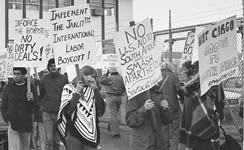 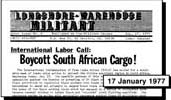 January 1977: SL-initiated protest on San Francisco pier of Nedlloyd Kimberley in solidarity with international labor boycott of South African transport. Above: Militant Caucus fought for ILWU action. Local 10 Tops Set Up Membership In the guise of protecting the union from sanctions by the PMA and the courts for an “illegal” work stoppage, the bureaucrats purveyed the fiction that the ILWU members implementing the boycott were carrying out individual “acts of conscience.” Local 10 official Tom Lupher told the San Francisco Chronicle (29 November 1984) that “the action was not officially sanctioned by the union membership, but was an action of protest by individuals.” This was echoed by Keylor’s bloc partner, Robinson, in a television interview in which he said, “This is an act of conscience on the part of individual longshoremen and it will remain as such.” The Longshore Militant (30 November 1984) exposed this treachery: “This policy is and has been intended to kill this union action by running it into the ground…. “Furthermore, the union’s position in the arbitration hearing on Wednesday is that PMA should penalize and fine individual members, not the union. Maybe we’re not real smart. We thought it was the job of the union to protect its members, not the members’ job to protect Herman’s cozy relationship with PMA…. “PMA means to break this action and they are getting help from the union officers and their stooges. These stalling tactics are not going to work…. It is necessary to act! We need a leadership capable of leading action. Picket the Nedlloyd Kimberley! Tell PMA to shove it! Shut down the port against any penalties!” Any leadership worth its salt obviously fights to defend the union against the bosses’ anti-labor laws—but not at the cost of setting up the membership of the union for victimization at the hands of these very laws! Yet this is exactly what the Local 10 tops’ efforts to “fool” the PMA did. Longshoremen dispatched to the Nedlloyd Kimberley refused to work the South African cargo and were fired for the day. The PMA then withheld two weeks of Pay Guarantee Payments, paid to non-casual longshoremen working out of the union’s hiring hall who have been unable to obtain enough work to meet a minimum income level. After the South African cargo sat untouched for ten days, on December 3 the PMA obtained an injunction against the action. The Local 10 leadership immediately caved in. As Longshore Militant No. 67 (4 January 1985) reported: “The officers seized on the injunction as a legal pretext to end the action on December 3. At the Exec. Board that night only Stan Gow argued to stop the dispatching and set up a union picket line and to shut down the port against PMA penalties. The cowardly attempt to play by the bosses’ rules only emboldened PMA to get a standing injunction ‘prohibiting’ future union action against the Nedlloyd ships.” Keylor did nothing to support Gow’s motion to mobilize the union’s power—the only way possible to successfully defy the injunction and to put some teeth into the boycott—which was ruled out of order by ILWU Local 10 president Larry Wing (see “Battle Over Union Action at South Africa Ship,” WV No. 368, 7 December 1984). Having opposed a solid union boycott, Keylor, on the morning after the bureaucrats succeeded in killing the action against the Nedlloyd Kimberley, was down on the pier urging the community protesters to set up a picket line! This was pure grandstanding, designed as a last-minute cover for his own despicable role. Keylor later complained in his Militant Longshoreman (7 January 1985) that in this after-the-fact charade, his erstwhile Stalinist allies “managed to turn the picket line into an impotent demonstration, and thereby destroyed it.” Sound familiar? This is exactly the role Keylor had played ten days earlier when he was working in cahoots with Robinson and the CP against the picket line set up by Gow and other ILWU members! As we wrote in “ILWU Anti-Apartheid Action Sabotaged—Labor Traitors and Their Lackeys” (WV No. 374, 8 March 1985): “In his leaflet, Keylor has some oh-so-polite criticisms of Robinson and his supporters who ‘honestly believe that Local 10 had no choice but to give in to the injunction,’ and who ‘have a commitment to individual acts of consciousness,’ etc. He wagged his finger at [the CP newspaper] People’s World for its reliance on the liberal Democrats. But you would never know from this that Keylor supported Robinson’s amendment to work the ship at the October 18 Local 10 meeting, that he chaired meetings of Robinson’s Southern African Liberation Support Committee (which was put in charge of the action by the officers), and worked hand in glove with Robinson and the CP right up until the injunction.” After doing everything he could to prevent the boycott from becoming a union political strike action, when it was all over, Keylor had the nerve to boast that “our union’s action was the longest political strike in memory on the West Coast”! As Longshore Militant No. 68 (1 February 1985) put it: “It’s not simply that Keylor is a liar. His leaflet reveals a method we’re all familiar with. The ILWU and especially Local 10 have a reputation as a ‘progressive union.’ What this means in practice is that union bureaucrats who know their way around the left are very good at spouting a lot of hot air in support of ‘social issues.’ But afterwards they do nothing concrete and/or sabotage efforts for real action.” 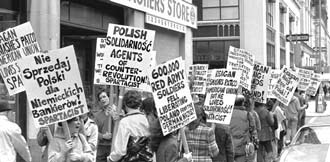 New York City 1981 SL demonstration exposed Polish Solidarność as company union for CIA, Wall Street and the Vatican. BT founders deserted from Trotskyism in face of Cold War II drive for counterrevolution in Soviet bloc. The BT School of Falsification To cover their tracks, Keylor and the ET/BT let loose with a barrage of lies against Stan Gow, the Militant Caucus and the Spartacist League. In its article “Militant Longshoremen ‘Hot-Cargo’ South African Goods—11-Day Anti-Apartheid Struggle On San Francisco Docks” (Bulletin of the External Tendency of the iSt No. 4, May 1985), the then-ET charged that we did “nothing to initiate or build the action.” In fact, the entire documented record shows that it was Gow and the Militant Caucus who fought for genuine labor action on the docks against the hated apartheid rulers—in opposition to Keylor and Robinson in their self-appointed role as flunkeys for the bureaucracy. The BT charges that we called the longshoremen who went onto the ship “scabs.” We certainly denounced Keylor and Robinson for pushing longshoremen across the picket line to work the ship. But WV saluted the longshoremen who refused to move the South African cargo. And, as the Longshore Militant (No. 66, 30 November 1984) said: “Not a man has touched that South African cargo, in spite of all this two-faced treachery and stupid dispatching. They are the real heroes, not Keylor and Robinson who stand outside the gate and applaud the very men they are setting up for victimization.” Well after the fact, Keylor and the ET/BT would invent the biggest lie of all in this whole frame-up, charging that Gow and the Militant Caucus acted as finks for the bosses because they had publicized the motion passed by Local 10. In its May 1985 article on the boycott, the ET/BT declared that “the SL-supported Longshore Militant (19 November) provided the crucial evidentiary material for the maritime employers’ injunction which ended the action,” adding that “the SL supporters knew perfectly well what they were doing when they published their report of the Local 10 boycott motion. This was the only ILWU-associated documentary material which the Pacific Maritime Association (PMA) could lay its hands on which mentioned the motion.” Four months earlier, in the 7 January 1985 issue of his Militant Longshoreman, Keylor had accurately charged that it was ILWU International president Jimmy Herman who had “laid the legal basis for PMA being able to get their apartheid injunction,” pointing out that Herman had “agreed with the PMA that our action was an ‘illegal work stoppage’ in violation of the contract.” Now, Keylor and the ET/BT were screaming that the Militant Caucus supplied the evidence for the injunction! Although on a smaller scale, this absurd smear job is cut of the same cloth as the charge that Lenin was being funded with gold from the German Kaiser, a slander circulated by those “socialists” in tsarist Russia who hated and feared the Bolsheviks’ fight for proletarian revolution. In the case of Keylor and the ET/BT, slandering us was once again used to cover for the criminal treachery of the bosses’ “labor lieutenants” in the ILWU bureaucracy. For that matter, if making motions passed by the union publicly available to the membership is to turn “state’s evidence,” then Keylor himself stands indicted. A month before Gow’s supposedly offending newsletter, on 12 October 1984 Keylor had issued his own leaflet publicizing the motion passed at the Local 10 Executive Board meeting that the union would “not work the next Nedlloyd Line ship carrying South African cargo” and urging the Local 10 ranks to “come to the membership meeting Thursday, October 18, and vote for final approval of the motion!” Publicizing decisions made at union meetings would seem elementary not simply to have an informed membership but in order to mobilize the union for struggle. Keylor and the ET/BT boasted of their role in leading “the most important political strike in at least a decade.” Gee, how do you wage such a strike without informing the membership and without the bosses knowing?! As we wrote at the time: “Yes, it’s quite a trick to conduct a political work stoppage, particularly the ‘longest in U.S. history,’ without running afoul of the capitalist state. In fact, it can’t be done. In the end, their whole charade about individual ‘acts of conscience’ didn’t fool the PMA, the arbitrators or the federal court. Robinson and Keylor did all this dirty work because the officers were afraid a union action would be ruled illegal under Taft-Hartley. To them ‘discipline’ means riding herd on the membership, and not even mentioning the local’s October 18 vote to boycott South African cargo, on the grounds that to do so jeopardizes the union. By trying to fool the class enemy with this cynical ploy, they managed to victimize the members and have the union hauled into court.” —“Labor Traitors and Their Lackeys,” WV No. 374, To this day, the ET/BT’s lies that we “sabotaged” the Nedlloyd Kimberley boycott are used by elements in the ILWU bureaucracy to cover their own tracks. An example is Jack Heyman, a former Local 10 business agent who has often served on the union Executive Board and in other official capacities. We have had many exchanges with Heyman over the years. Virtually every time that we have caught him out on the contradiction between the militant words that he sometimes spouts and what he actually does on the ground, he falls back on the deception that we opposed the Nedlloyd Kimberley boycott. (See letter page 2.) 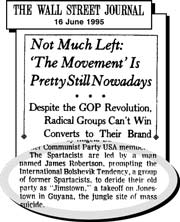 As SL and PDC mobilized to stop execution of Mumia Abu-Jamal in 1995, capitalists’ mouthpiece picked up BT’s “cult” smear to vilify Mumia’s supporters. Last October, Heyman was Local 10’s speaker at a united-front rally in defense of Mumia Abu-Jamal—America’s foremost class-war prisoner—radical lawyer Lynne Stewart and exiled Black Panther Assata Shakur. The rally was organized by the Partisan Defense Committee, a legal and social defense organization associated with the Spartacist League. ILWU Local 10 has for many years been active in the defense of Mumia and was one of the first unions to lend its support to the PDC’s efforts to save Mumia from the capitalist state’s executioners. At the October rally, Heyman made much of his part in organizing the West Coast port shutdown in defense of Mumia on 24 April 1999—an expression of the kind of social power that needs to be mobilized in a class-struggle fight to free Mumia and abolish the racist death penalty. But Heyman didn’t like to be reminded that a Local 10 motion he authored explicitly endorsed the “Millions for Mumia” demonstration the same day whose central demand was the call for a “new trial.” As an SL speaker at the October rally argued, this is not a matter of mere words but of counterposed political perspectives and strategies. The fight to free Mumia means a class-struggle fight in opposition to the capitalist state that framed up this innocent man and sentenced him to death in 1982 because of his defiant and eloquent opposition to the racism, brutality and terror of capitalist class rule (see “For a Class-Struggle Fight to Free Mumia Abu-Jamal!” WV No. 872, 9 June). The call for a “new trial” sows the illusion that Mumia can get justice from the same racist injustice system that railroaded him. It is aimed at liberals and others who see Jamal’s case not as the frame-up of an innocent man but simply as an isolated “miscarriage of justice.” (For our response to a letter from Heyman complaining of our coverage of this rally, see “Jack Heyman: ‘In the Bag’,” WV No. 864, 17 February.) Trying to get out from under the role he played in providing a “militant” cover for the liberal-reformist politics of the rally organizers in April 1999, Heyman played the Nedlloyd Kimberley card at the October rally, arguing: “In 1984 there was an important action against the ship that came in from South Africa, against apartheid, that the Spartacist League had a problem with. And initially they did not support this action. In the midst of it—it was a ten-day action against a ship from South Africa—the longshore union decided to protest apartheid by not working the ship. And it took several days before the Spartacist League changed their position on that.” He used this charge to tar us as sectarians “abstaining from important class struggle,” including “when it’s important to be there to fight for Mumia Abu-Jamal.” 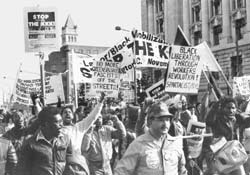 November 1982 SL-initiated labor/black mobilization that stopped Klan in D.C. Keylor/BT sneered that we were turning away from the unions toward the ghettos. Sneering at the “Ghetto Unemployed” That the BT’s lies are picked up to go after us in the urgent fight for Mumia’s freedom is grotesque. The Partisan Defense Committee took up Mumia’s cause almost 20 years ago, working to make his case widely known and to get broader forces, particularly the unions, to take up the fight for his freedom. When a death warrant was signed against Mumia in the summer of 1995, tens of thousands of people in the U.S. and many more around the globe rallied in his defense. As part of the rulers’ efforts to portray Mumia as a depraved “cop killer,” the Wall Street Journal (16 June 1995) happily picked up the BT’s slanders of our organization as a deranged “cult” in order to smear the PDC. This May at a Socialist Action meeting on Mumia’s case in San Francisco, Keylor shamelessly defended this, declaring that it wasn’t their “fault” that the Wall Street Journal picked up the BT’s lies against us. But while its voluminous writings against the SL provided ammunition for the media mouthpiece of American capitalism to try to undercut the campaign on behalf of Mumia, the Bolshevik Tendency did not write an article in its press in Mumia’s defense until 1996! And why would they? Their shameless boasts of having led a “political strike” in solidarity with the brutally oppressed black workers and masses of South Africa are all the more cynical when one considers that Keylor and the ET/BT were at the same time sneering at our efforts to mobilize the power of the multiracial working class in defense of the black population of this country against racist terror. Following the 5,000-strong labor/black mobilization initiated by the Spartacist League that ran the Klan off the streets of Washington, D.C., on 27 November 1982, Keylor’s Militant Longshoreman (No. 5, 4 February 1983) opined that the Militant Caucus “and their co-thinkers in Workers Vanguard are increasingly directing their organizing activity away from the unions and towards the unemployed, particularly in the ghettos”! In the U.S., the vicious segregation and racial oppression of the black population is a key prop to maintaining the raw exploitation of labor. By the same token, the fight to mobilize labor’s power in defense of the black masses is central to the fight for the emancipation of the working class as a whole through socialist revolution. This understanding, captured in Karl Marx’s statement in Capital that “labour cannot emancipate itself in the white skin where in the black it is branded,” has infused the work of our organization since its inception—from our efforts to intervene into the civil rights struggles of the 1960s to our later anti-fascist mobilizations and our fight for Mumia’s freedom. In one of its first major documents, the then-External Tendency derided our efforts to build labor/black defense leagues (which are currently active in New York City, Chicago, Los Angeles and the Bay Area) as a “shift away” from “the organized working class” toward “community organizing.” Our mobilizations for the unity and integrity of the working class against capitalist “divide and rule” racism and its fascist shock troops are themselves a fight in defense of the unions. Only those for whom “the working class” means the labor bureaucracy could think otherwise. It was precisely such an identification of the working class with the union misleaders that animated the ET/BT around the Nedlloyd Kimberley boycott. The ET/BT cried in shocked disbelief when we compared then United Auto Workers president Doug Fraser’s joining the Chrysler board of directors to the German Social Democrats’ voting for war credits for the German capitalist rulers on 4 August 1914. This was the point at which the Social Democrats acted not just as sellouts but as direct agents for the Kaiser, mobilizing workers to die for the profits of German capitalism in the interimperialist World War I. Likewise, Fraser became an open company cop in the pay of the auto bosses, and one need look no further than the devastated remains of Detroit, the former “Motor City,” to see the results to which he contributed. Renegades for Hire At the time of the 1984 Nedlloyd Kimberley boycott, the ET/BT was screaming that we were capitulating to Stalinism because of our hard-edged defense of the Soviet Union against imperialist-inspired counterrevolution. Meanwhile, in the ILWU Keylor was making common cause with a supporter of the Communist Party —apologists for the Kremlin Stalinist bureaucracy and its treacherous policy of “peaceful coexistence” with imperialism—against those fighting for a program of proletarian internationalism. The history of the U.S. labor movement is riddled with such types who, having given up on class struggle, find their place doing the bidding of the union bureaucracy. People who no longer have the stomach for revolutionary politics also sometimes bear animus toward Marxism as the “god that failed” them. But it is odd indeed to found an organization based on such malice, which has overwhelmingly defined the ET/BT since its inception. For some 25 years, this outfit has devoted much of its energies to destroying the party that they so ignominiously deserted. As we have noted, hostility doesn’t make a political program or reason for existence as a putatively socialist organization. That takes a different kind of animating principle. And the BT has its own Dr. Frankenstein in its leader Bill Logan. Logan was expelled from the international Spartacist tendency at our first international conference in 1979, following a thorough International Control Commission investigation and a trial, as “a proven, massive liar and a sexual sociopath who manipulated the private lives of comrades for reasons of power politics and his own aberrant appetites and compulsions in the guise of Marxism.” The BT’s slanders of the Spartacist League as a sinister “obedience cult” are a responsive cover-up for Logan, who has the demonstrated credentials of a manipulative cult leader. He willfully broke up couples and pressured comrades into sexual relationships. He pressured a young comrade to have an abortion, and when she refused he prodded her to put her child in a foster home, ultimately driving her to attempt suicide. These days, Logan advertises his services as a “celebrant” for baby funerals and “partnership break-up” among other things. The head of a putative “Bolshevik” organization, he refers on his Web site (www.bl.co.nz) not to the influences of Marx, Engels, Lenin or Trotsky but to the “Anglican and Presbyterian influences of my childhood.” The motion expelling Logan from our organization, which was passed unanimously by the delegates at the 1979 conference, concluded that he “cannot be and should never have been a member of a working-class organization.” But he was happily embraced by the BT because he suits its purpose (or perhaps its purpose suits him). And that should tell you a lot about this organization. Our purpose is to fight to build the mass revolutionary party that can lead the necessary struggle for the socialist liberation of humanity from the increasingly depraved rule of capitalist imperialism. Taking on the ET/BT’s lies over the Nedlloyd Kimberley is a defense of our revolutionary program, purpose and heritage, which goes right back to the Bolshevik Party of Lenin and Trotsky that led the working class to power in the first, and only, successful proletarian revolution—in Russia in 1917. Examining the real history of the Nedlloyd Kimberley boycott is also crucial to arming a new generation of working-class fighters. Learning from the past is a vital component of the struggle to make the unions instruments of the revolutionary movement of the working class, not the secondary instruments of imperialist capitalism in which the labor bureaucracy serves to discipline the workers and obstruct the program and policies of class struggle.
|
|
||||||||||||||||||||||||||||||||||||||||||||||||||||||||||||||||||
